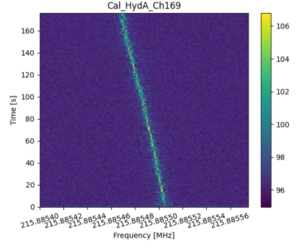Project area/s
- Searches for Extra Terrestrial Intelligence (SETI)
Project Details
The discovery of nearly 7000 extrasolar planets opens a possibility to look for signatures of technologically advanced civilisations inhabiting these planets (the so-called technosignatures). It is estimated that some 20% of extrasolar planets are located in the so-called Goldilocks zones, where conditions (especially existence of liquid water) support existence of life. Such systems are the primary target for on-going Searches for Extra Terrestrial Intelligence (SETI).

Example of candidate SETI signal detected in the data from the Murchison Widefield Array
Radio observations are one of the most promising avenues for SETI. Thus, the main goal of this project is to select a few exo-planetary systems and use an SKA-Low prototype station, the Engineering Development Array 2 (EDA2) to try to detect SETI signals at frequencies below 300 MHz. We will record a few hours of data on each target system, and process these data to look for technosignatures. Nobody knows exactly how such technosignatures may look like, but there are some predictions and their templates have been implemented in SETI software packages.
We will use existing data processing software for EDA2 telescope and SETI packages (e.g. TurboSETI) to identify such signals. The discovery of a technosignature would be an incredible breakthrough with unpredictable scientific and philosophical consequences. However, even If no interesting signals are discovered we will place limits on the maximum power emitted from these planets in radio band and compare this to the current total power emitted by Earth based transmitters over similar frequencies.
Student Attributes
Academic Background
Programming in scripting languages (bash and python). It may be sufficient if the student is proficient in programming in some other language and can quickly learn python.
Astronomy/astrophysics background will be useful, but is not critical for this project.
Computing Skills
Python, bash scripting, Linux environment
Training Requirement
Introduction to HPC computing. If the candidate does not know python some basic training will be useful too.
Project Timeline
| Week 1 | Inductions and project introduction |
| Week 2 | Initial presentation |
| Week 3 | Get familiar with EDA2 processing software and data used in this project. The data are high time resolution complex voltages from the EDA2 station beam converted to dynamic spectra. Start selecting target planetary systems and perform EDA2 observations. |
| Week 4 | Complete selection of target planetary systems and continue EDA2 observations. Perform a pilot processing of a small amount of data to develop a reasonably automatic procedure leading to filterbank files in the required time and frequency resolution (to be decided). Start testing and executing TurboSETI (or other software – TBD) on the resulting filterbank files and generating SETI signal candidates. Adjust the processing parameters. |
| Week 5 | Complete observations of the selected targets and continue data processing. Incorporate TurboSETI into the full pipeline and process all recorded data. |
| Week 6 | Complete data processing and identify a short list of best signal candidates for SETI signals. |
| Week 7 | Summarise the results by categorising different types of candidates (RFI etc.) and short listing the best SETI signal candidates. Analyse the best possible SETI candidates. Is any of them worth further investigation or follow-up observations? If so, perform additional observations and data processing. |
| Week 8 | Finalise the findings. Is there any interesting SETI candidate detected. If so, try to understand this signal better etc. Using sensitivity of the telescope, calculate upper limits on the total power emitted by the observed systems in the observed frequency band. |
| Week 9 | Final presentation |
| Week 10 | Final report |